engine Alfa Romeo 8C 2010 Owner handbook (in English)
[x] Cancel search | Manufacturer: ALFA ROMEO, Model Year: 2010, Model line: 8C, Model: Alfa Romeo 8C 2010Pages: 223, PDF Size: 14.35 MB
Page 206 of 223

204
8
BODYWORKPROTECTION FROM
ATMOSPHERIC AGENTS
The main causes of the corrosion phenomena
are:
- atmospheric pollution
- salinity and humidity in the atmosphere
(sea areas or humid climate)
- seasonal environmental conditions.
- salt scattered on the road surface to melt
ice and snow.
The abrasive action of atmospheric dust and
wind-carried sand, mud and stones should not be
underestimated.
For your vehicle, Alfa Romeo has adopted
the best technological solutions to protect the
bodywork from corrosion. The main measures are:
- Paint products and systems that provide the
vehicle with high-resistance features against
corrosion and abrasion.
- Use of galvanized (or pre-treated) metal
sheets whose most exposed parts are highly
resistant against corrosion.
- Spraying of the underbody, engine
compartment, internal part of the
wheelhouse and of other parts using highly
protective wax products.
- Spraying of the plastic material most
exposed parts with protective function:
under the doors, inside part of the
mudguards, edges, etc.
- Use of ventilated box sections treated
with wax products, to prevent water
condensation and pooling, which may lead
to the internal formation of rust.TIPS FOR KEEPING THE
BODYWORK IN GOOD
CONDITION
Paint
Paint does not only have an aesthetic function
but also serves to protect the metal sheets.
In the event of abrasions or deep scratches,
we recommend that you have the necessary
touch-ups made immediately, to avoid any rust
formation.
Touch-ups do not feature particular difficulties,
even on metallic finishes. For all paint touch-ups,
use only the genuine products indicated on the
label applied on the engine compartment lid.
Page 207 of 223

205
8
MAINTENANCE
Normal paint maintenance consists in washing,
the frequency of which depends on the
conditions of use and of the environment.
For example, in areas where there is high
atmospheric pollution or if the roads are spread
with anti-freeze salt, it is advisable to wash the
vehicle more frequently. WARNING: Detergents pollute water. Therefore
the vehicle should be washed in areas equipped
for the collection and purification of the fluids
used for washing.For correct washing:
- Wet the bodywork with a low-pressure
water jet.
- Run a sponge soaked in a neutral detergent
solution over the bodywork, remembering
to rinse the sponge frequently.
- Thoroughly rinse with water and dry with a
jet of air or suede.
When drying, take particular care with the parts
that are less visible, such as the door bays, front
lid, headlight edges, in which water can be
trapped more easily. You are recommended not to take the vehicle
immediately into an enclosed environment, but
leave it in the open air so as to allow the water
to evaporate.
Do not wash the vehicle after it has been left in
the sun or when the hood is hot: the paint gloss
could be affected.
External plastic parts must be cleaned with the
same procedure followed for the normal washing
of the vehicle.
Avoid, as far as possible, parking the vehicle
under trees; the resinous substances that very
often drop from the trees give the paint a dull
appearance and increase the possibility of
originating corrosive processes.
WARNING: Bird droppings must be washed off
immediately and thoroughly, since their acidity is
particularly corrosive.
WARNING: To provide better protection for the
paint, polish the vehicle at regular intervals with
a suitable product leaving a protective film on
the paint.
Windows
To clean the windows use special detergents.
Only use clean cloths so as not to scratch the
windows or rendering them less transparent. WARNING: In order not to damage the electric
elements fitted inside the heated rear window,
rub gently following the direction of the
elements. ENGINE COMPARTMENT
At the end of each winter season, carefully wash
the engine compartment, remembering to not
direct the jet of water for too long on the ECUs
and on the relay and fuse boxes on the right-
hand side of the engine compartment (driving
direction). To perform this operation, you must
contact a specialised workshop. WARNING: Wash only when the engine is cold
and with the ignition key turned to STOP. After
washing, make sure that the various protections
(e.g. rubber boots/caps, guards etc.) have not
been removed or damaged.
Page 209 of 223

207
8
MAINTENANCE
the Authorised Service Centres of the
Manufacturer’s Network). Do not use
thick plastic sheets, which do not allow
the humidity on the vehicle surface to
evaporate.
- Infl ate the tyres up to a pressure which
must be 0.5 bar higher than the normally
prescribed one, and check it at regular
intervals.
CAUTION
The tyre pressure must be
brought back to the prescribed value
before reusing the vehicle.
- Do not drain the engine cooling system. BATTERY CONDITIONER
SOCKET
Located under the left-hand seat, it can be
accessed by moving the seat forward and folding
down the backrest.
IF THE VEHICLE
IS LAID UP FOR
LONG PERIODS- If the vehicle is not used for several months,
take the following precautions:
- Wash and dry the vehicle thoroughly.
- Store the vehicle in a covered, dry and, if
possible, ventilated area.
- Engage a gear.
- Disconnect the battery (see page 168).
- Check the battery charge condition. This
check should be carried out monthly while
the vehicle is idle. Recharge the battery if
the load-free voltage is below 12.5 V.
- Check that the electric parking brake is not
applied.
- Clean and protect the painted parts applying
protective waxes.
- Clean and protect polished metal parts with
specifi c products available on the market.
- Talc the windscreen wiper blades and raise
them from the windscreen.
- Cover the vehicle with a fabric sheet
to allow transpiration (available at all
Page 212 of 223
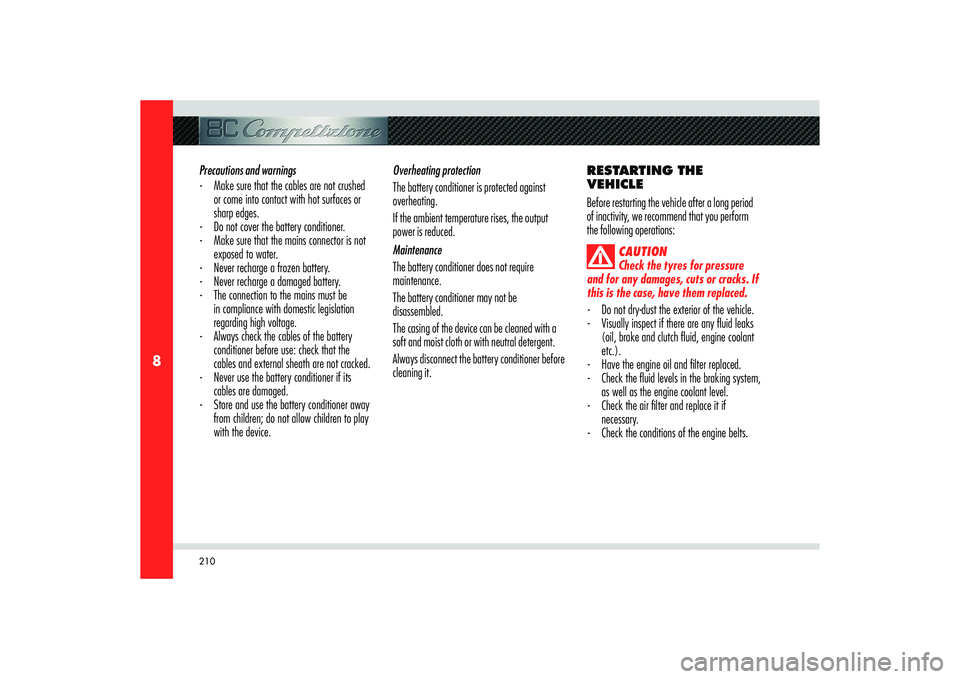
210
8
Precautions and warnings
- Make sure that the cables are not crushed
or come into contact with hot surfaces or
sharp edges.
- Do not cover the battery conditioner.
- Make sure that the mains connector is not
exposed to water.
- Never recharge a frozen battery.
- Never recharge a damaged battery.
- The connection to the mains must be
in compliance with domestic legislation
regarding high voltage.
- Always check the cables of the battery
conditioner before use: check that the
cables and external sheath are not cracked.
- Never use the battery conditioner if its
cables are damaged.
- Store and use the battery conditioner away
from children; do not allow children to play
with the device.Overheating protection
The battery conditioner is protected against
overheating.
If the ambient temperature rises, the output
power is reduced.
Maintenance
The battery conditioner does not require
maintenance.
The battery conditioner may not be
disassembled.
The casing of the device can be cleaned with a
soft and moist cloth or with neutral detergent.
Always disconnect the battery conditioner before
cleaning it.RESTARTING THE
VEHICLE
Before restarting the vehicle after a long period
of inactivity, we recommend that you perform
the following operations:
CAUTION
Check the tyres for pressure
and for any damages, cuts or cracks. If
this is the case, have them replaced.
- Do not dry-dust the exterior of the vehicle.
- Visually inspect if there are any fl uid leaks
(oil, brake and clutch fl uid, engine coolant
etc.).
- Have the engine oil and fi lter replaced.
- Check the fl uid levels in the braking system,
as well as the engine coolant level.
- Check the air fi lter and replace it if
necessary.
- Check the conditions of the engine belts.
Page 213 of 223

211
8
MAINTENANCE
RE-CONNECTING THE
BATTERY
- open the right-hand door
- remove the luggage shelf behind the seats
- remove the battery case cover
- connect the battery
- unlock and lock the doors using the remote
control or the key in the door lock
- turn on the instrument panel and adjust the
date and time setting in the Setup menu.WARNING: Each time the battery is reconnected,
wait at least 30 seconds with the ignition key
in position MAR before starting the engine.
This enables the electronic system that controls
the motor-driven valves to run a self-learning
procedure. At the same time, you can also set
the date and time on the instrument panel.
- Reconnect the battery after having checked
its charge condition and perform the
initialisation procedures where required.
In this regard, consult the chapter
“Reconnecting the battery” in this section.
- With the gearshift in neutral (N), let the
engine idle for several minutes
CAUTION
This operation must be
performed outdoors. Exhaust gases
contain carbon monoxide which is
strongly toxic and potentially lethal.
RADIO-
FREQUENCY
REMOTE
CONTROL:
MINISTERIAL
HOMOLOGATION Some countries do not require a specific domestic
homologation in the event that the vehicle has
already obtained other European homologations.
Page 218 of 223
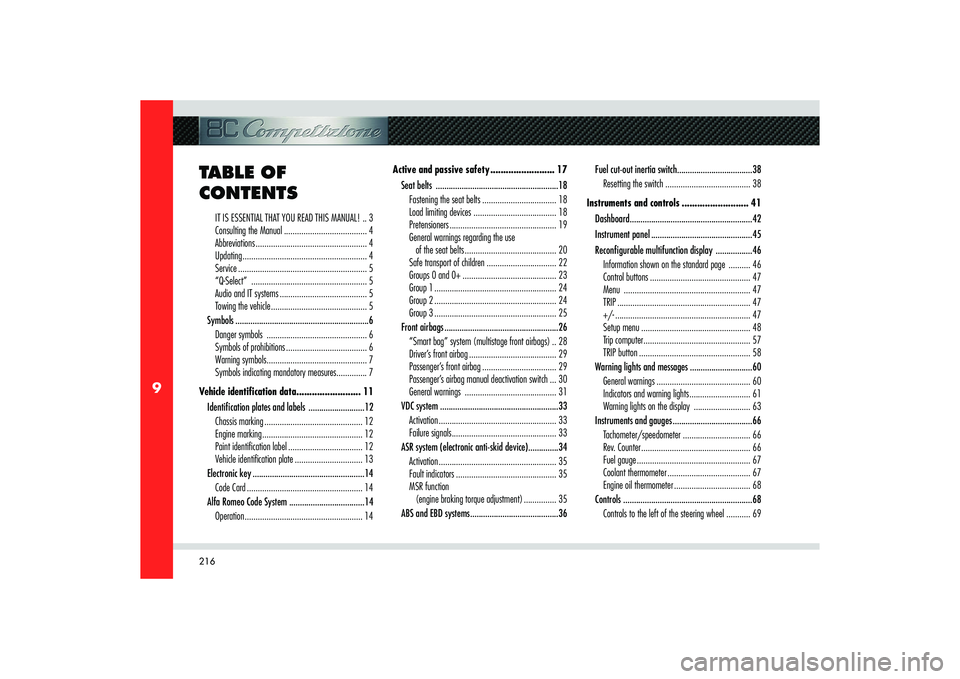
216
9
IT IS ESSENTIAL THAT YOU READ THIS MANUAL! .. 3
Consulting the Manual ...................................... 4
Abbreviations ................................................... 4
Updating ......................................................... 4
Service ........................................................... 5
“Q-Select” ..................................................... 5
Audio and IT systems ........................................ 5
Towing the vehicle ............................................ 5
Symbols ..............................................................6
Danger symbols .............................................. 6
Symbols of prohibitions ..................................... 6
Warning symbols .............................................. 7
Symbols indicating mandatory measures .............. 7
Vehicle identifi cation data ......................... 11
Identi� cation plates and labels ..........................12
Chassis marking ............................................. 12
Engine marking .............................................. 12
Paint identifi cation label .................................. 12
Vehicle identifi cation plate ............................... 13
Electronic key ....................................................14
Code Card ..................................................... 14
Alfa Romeo Code System ...................................14
Operation ...................................................... 14Active and passive safety ......................... 17
Seat belts .........................................................18
Fastening the seat belts .................................. 18
Load limiting devices ...................................... 18
Pretensioners ................................................. 19
General warnings regarding the use
of the seat belts .......................................... 20
Safe transport of children ................................ 22
Groups 0 and 0+ ........................................... 23
Group 1 ........................................................ 24
Group 2 ........................................................ 24
Group 3 ........................................................ 25
Front airbags .....................................................26
“Smart bag” system (multistage front airbags) .. 28
Driver’s front airbag ........................................ 29
Passenger’s front airbag .................................. 29
Passenger’s airbag manual deactivation switch ... 30
General warnings .......................................... 31
VDC system .......................................................33
Activation ...................................................... 33
Failure signals ................................................ 33
ASR system (electronic anti-skid device) ..............34
Activation ...................................................... 35
Fault indicators .............................................. 35
MSR function
(engine braking torque adjustment) ............... 35
ABS and EBD systems .........................................36Fuel cut-out inertia switch ...................................38
Resetting the switch ....................................... 38
Instruments and controls .......................... 41
Dashboard .........................................................42
Instrument panel ...............................................45
Recon� gurable multifunction display .................46
Information shown on the standard page .......... 46
Control buttons .............................................. 47
Menu .......................................................... 47
TRIP ............................................................. 47
+/- .............................................................. 47
Setup menu .................................................. 48
Trip computer ................................................. 57
TRIP button ................................................... 58
Warning lights and messages .............................60
General warnings ........................................... 60
Indicators and warning lights ............................ 61
Warning lights on the display .......................... 63
Instruments and gauges .....................................66
Tachometer/speedometer ............................... 66
Rev. Counter .................................................. 66
Fuel gauge .................................................... 67
Coolant thermometer ...................................... 67
Engine oil thermometer ................................... 68
Controls ............................................................68
Controls to the left of the steering wheel ........... 69
TABLE OF
CONTENTS
Page 219 of 223
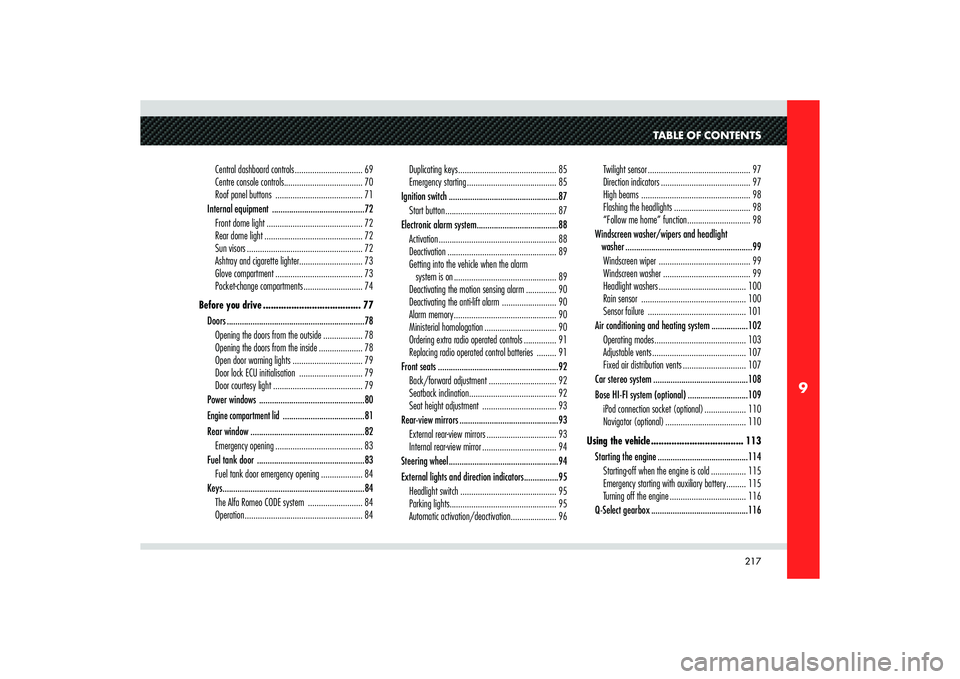
217
9
TABLE OF CONTENTS
Central dashboard controls ............................... 69
Centre console controls .................................... 70
Roof panel buttons ........................................ 71
Internal equipment ...........................................72
Front dome light ............................................ 72
Rear dome light ............................................. 72
Sun visors ..................................................... 72
Ashtray and cigarette lighter ............................. 73
Glove compartment ........................................ 73
Pocket-change compartments ........................... 74
Before you drive ...................................... 77
Doors ................................................................78
Opening the doors from the outside .................. 78
Opening the doors from the inside .................... 78
Open door warning lights ................................ 79
Door lock ECU initialisation ............................. 79
Door courtesy light ......................................... 79
Power windows .................................................80Engine compartment lid
......................................81
Rear window .....................................................82
Emergency opening ........................................ 83
Fuel tank door ..................................................83
Fuel tank door emergency opening ................... 84
Keys ..................................................................84
The Alfa Romeo CODE system ......................... 84
Operation ...................................................... 84Duplicating keys ............................................. 85
Emergency starting ......................................... 85
Ignition switch ...................................................87
Start button ................................................... 87
Electronic alarm system ......................................88
Activation ...................................................... 88
Deactivation .................................................. 89
Getting into the vehicle when the alarm
system is on ............................................... 89
Deactivating the motion sensing alarm .............. 90
Deactivating the anti-lift alarm ......................... 90
Alarm memory ............................................... 90
Ministerial homologation ................................. 90
Ordering extra radio operated controls ............... 91
Replacing radio operated control batteries ......... 91
Front seats ........................................................92
Back/forward adjustment ............................... 92
Seatback inclination ........................................ 92
Seat height adjustment .................................. 93
Rear-view mirrors ..............................................93
External rear-view mirrors ................................ 93
Internal rear-view mirror .................................. 94
Steering wheel ...................................................94
External lights and direction indicators ................95
Headlight switch ............................................ 95
Parking lights ................................................. 95
Automatic activation/deactivation ..................... 96Twilight sensor ............................................... 97
Direction indicators ......................................... 97
High beams .................................................. 98
Flashing the headlights ................................... 98
“Follow me home” function ............................. 98
Windscreen washer/wipers and headlight
washer ...........................................................99
Windscreen wiper .......................................... 99
Windscreen washer ........................................ 99
Headlight washers ........................................ 100
Rain sensor ................................................ 100
Sensor failure ............................................. 101
Air conditioning and heating system .................102
Operating modes .......................................... 103
Adjustable vents ........................................... 107
Fixed air distribution vents ............................. 107
Car stereo system ............................................108
Bose HI-FI system (optional) ............................109
iPod connection socket (optional) ................... 110
Navigator (optional) ..................................... 110
Using the vehicle .................................... 113
Starting the engine ..........................................114
Starting-off when the engine is cold ................ 115
Emergency starting with auxiliary battery ......... 115
Turning off the engine ................................... 116
Q-Select gearbox .............................................116
Page 220 of 223
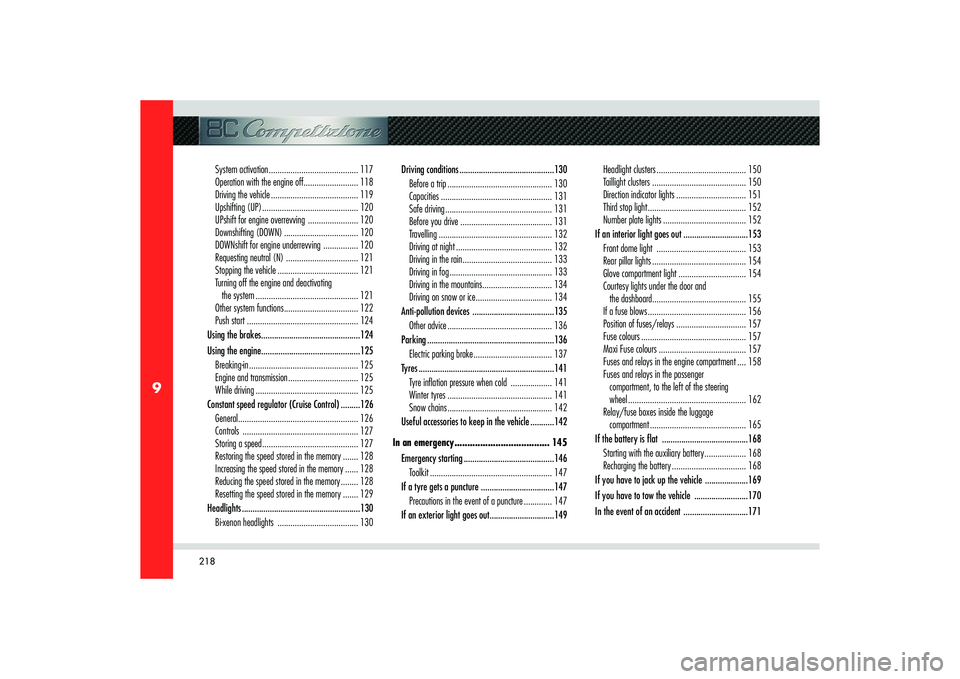
218
9
System activation ......................................... 117
Operation with the engine off ......................... 118
Driving the vehicle ........................................ 119
Upshifting (UP) ............................................ 120
UPshift for engine overrevving ....................... 120
Downshifting (DOWN) .................................. 120
DOWNshift for engine underrevving ................ 120
Requesting neutral (N) ................................. 121
Stopping the vehicle ..................................... 121
Turning off the engine and deactivating
the system ............................................... 121
Other system functions .................................. 122
Push start ................................................... 124
Using the brakes ..............................................124
Using the engine ..............................................125
Breaking-in .................................................. 125
Engine and transmission ................................ 125
While driving ............................................... 125
Constant speed regulator (Cruise Control) .........126
General ....................................................... 126
Controls ..................................................... 127
Storing a speed ............................................ 127
Restoring the speed stored in the memory ....... 128
Increasing the speed stored in the memory ...... 128
Reducing the speed stored in the memory ........ 128
Resetting the speed stored in the memory ....... 129
Headlights .......................................................130
Bi-xenon headlights ..................................... 130Driving conditions ............................................130
Before a trip ................................................ 130
Capacities ................................................... 131
Safe driving ................................................. 131
Before you drive .......................................... 131
Travelling .................................................... 132
Driving at night ............................................ 132
Driving in the rain ......................................... 133
Driving in fog ............................................... 133
Driving in the mountains ................................ 134
Driving on snow or ice ................................... 134
Anti-pollution devices ......................................135
Other advice ................................................ 136
Parking ...........................................................136
Electric parking brake .................................... 137
Tyres ...............................................................141
Tyre infl ation pressure when cold ................... 141
Winter tyres ................................................ 141
Snow chains ................................................ 142
Useful accessories to keep in the vehicle ...........142
In an emergency ..................................... 145
Emergency starting ..........................................146
Toolkit ........................................................ 147
If a tyre gets a puncture ..................................147
Precautions in the event of a puncture ............. 147
If an exterior light goes out ..............................149Headlight clusters ......................................... 150
Taillight clusters ........................................... 150
Direction indicator lights ................................ 151
Third stop light ............................................. 152
Number plate lights ...................................... 152
If an interior light goes out ..............................153
Front dome light ......................................... 153
Rear pillar lights ........................................... 154
Glove compartment light ............................... 154
Courtesy lights under the door and
the dashboard ........................................... 155
If a fuse blows ............................................. 156
Position of fuses/relays ................................ 157
Fuse colours ................................................ 157
Maxi Fuse colours ........................................ 157
Fuses and relays in the engine compartment .... 158
Fuses and relays in the passenger
compartment, to the left of the steering
wheel ...................................................... 162
Relay/fuse boxes inside the luggage
compartment ............................................ 165
If the battery is � at ........................................168
Starting with the auxiliary battery ................... 168
Recharging the battery .................................. 168
If you have to jack up the vehicle ....................169
If you have to tow the vehicle .........................170
In the event of an accident ..............................171
Page 221 of 223
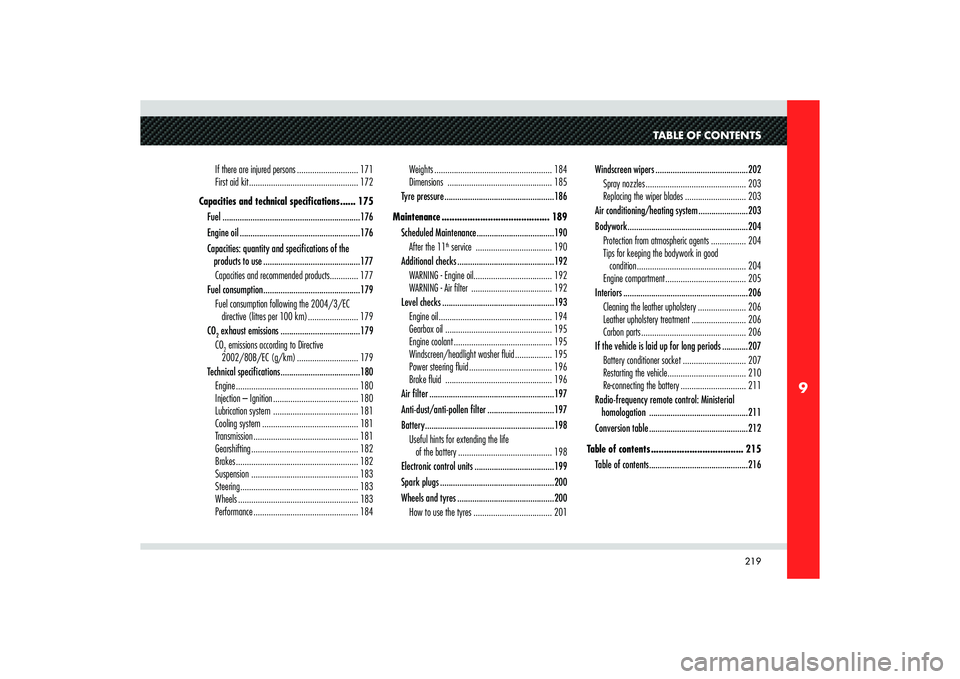
219
9
TABLE OF CONTENTS
If there are injured persons ............................ 171
First aid kit .................................................. 172
Capacities and technical specifi cations ...... 175
Fuel ................................................................176
Engine oil ........................................................176
Capacities: quantity and speci� cations of the
products to use .............................................177
Capacities and recommended products ............. 177
Fuel consumption .............................................179
Fuel consumption following the 2004/3/EC
directive (litres per 100 km) ....................... 179
CO2 exhaust emissions .....................................179
CO2 emissions according to Directive
2002/80B/EC (g/km) ............................ 179
Technical speci� cations .....................................180
Engine ........................................................ 180
Injection – Ignition ....................................... 180
Lubrication system ....................................... 181
Cooling system ............................................ 181
Transmission ................................................ 181
Gearshifting ................................................. 182
Brakes ........................................................ 182
Suspension ................................................. 183
Steering ...................................................... 183
Wheels ....................................................... 183
Performance ................................................ 184Weights ...................................................... 184
Dimensions ................................................ 185
Tyre pressure ...................................................186
Maintenance .......................................... 189
Scheduled Maintenance ....................................190
After the 11
th service ................................... 190
Additional checks .............................................192
WARNING - Engine oil .................................... 192
WARNING - Air fi lter ..................................... 192
Level checks ....................................................193
Engine oil .................................................... 194
Gearbox oil ................................................. 195
Engine coolant ............................................. 195
Windscreen/headlight washer fl uid ................. 195
Power steering fl uid ...................................... 196
Brake fl uid ................................................. 196
Air � lter ..........................................................197
Anti-dust/anti-pollen � lter ...............................197
Battery ............................................................198
Useful hints for extending the life
of the battery ........................................... 198
Electronic control units .....................................199
Spark plugs .....................................................200
Wheels and tyres .............................................200
How to use the tyres .................................... 201Windscreen wipers ...........................................202
Spray nozzles .............................................. 203
Replacing the wiper blades ............................ 203
Air conditioning/heating system .......................203
Bodywork ........................................................204
Protection from atmospheric agents ................ 204
Tips for keeping the bodywork in good
condition .................................................. 204
Engine compartment ..................................... 205
Interiors ..........................................................206
Cleaning the leather upholstery ...................... 206
Leather upholstery treatment ......................... 206
Carbon parts ................................................ 206
If the vehicle is laid up for long periods ............207
Battery conditioner socket ............................. 207
Restarting the vehicle .................................... 210
Re-connecting the battery .............................. 211
Radio-frequency remote control: Ministerial
homologation ..............................................211
Conversion table ..............................................212
Table of contents .................................... 215
Table of contents ..............................................216